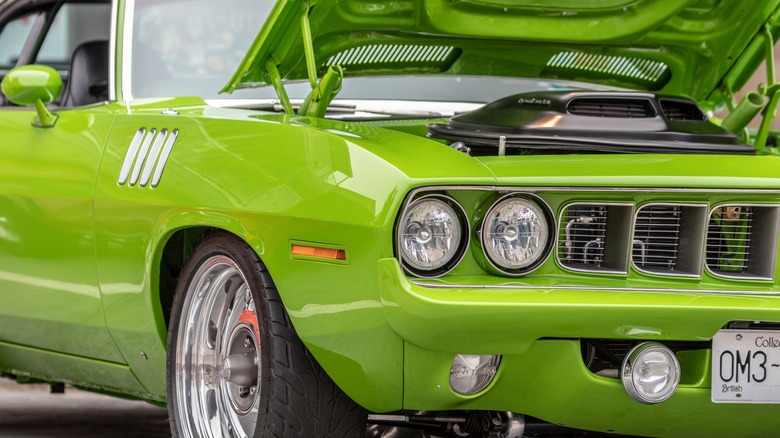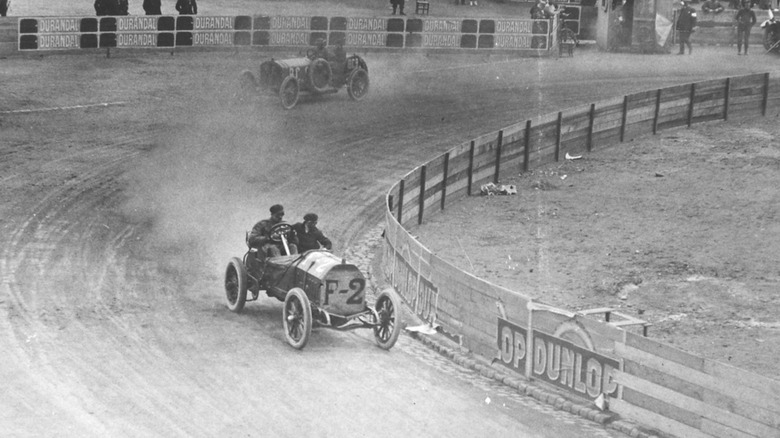What Was The First HEMI Engine And How Did It Change The Future Of Chrysler?
The HEMI logo plastered on modern Dodge cars and Ram trucks promises an increased level of automotive engine performance. But what's the difference between a hemi and a non-hemi engine? The primary difference is the hemi's dome-shaped (hemispherical) cylinder head combustion chambers compared to the relatively flat or wedge-shaped combustion chambers present in other cylinder head types. The hemi head design allows larger valves that increase the engine's internal air-fuel mixture and exhaust flow and a centrally located spark plug (or two) for more efficient combustion.
People most closely associate the hemi engine with Chrysler due to the automaker's HEMI trademark. However, around the same time that the 426 HEMI was making its mark on the muscle car scene, Ford released its Boss 429 with a similar hemi head design.
There's no question that Chrysler made the hemi engine design famous, especially among modern automobile enthusiasts. The earliest Chrysler automobiles featuring the 331-cubic inch FirePower V8 first-generation HEMI engines came out in 1951, but the hemi engine story doesn't begin there. In fact, it doesn't even start in an automobile.
The first hemi engine design
The first hemi engine, with its design widely credited to Allie Ray Welch from Chelsea, Wisconsin, was built by the Truscott Launch and Engine Company in 1901 and served as a two-cylinder boat engine. Others refute the proposition of Welch as the inventor of the hemi head design, giving sole credit to Truscott.
With a similarly murky history, MotorTrend gives credit for the first hemi-powered car to the Belgian automobile manufacturing company, also known as Pipe, for its four-cylinder hemi in 1905. Another hemi engine example, built in the United States (also in 1905), was the Premier racing car, which Curbside Classics credits as the first hemi-powered car.
Fiat took hemi technology to the races at the 1907 French Grand Prix, taking first place with its 130-horsepower hemi engine-powered race car and Felice Nazzaro behind the wheel. Decades of development and two World Wars led to the hemi technology present in the first-generation FirePower V8 and changed the future of Chrysler.
[Featured image by Jules Beau (1864-1932) via Wikimedia Commons | Cropped and scaled | Public Domain]
Chrysler HEMI history
During WWII, Chrysler developed a special hemi engine for use in military aircraft. The XI-2220 engine, a 2,220-cubic inch V16 hemi, produced 2,500 horsepower. The first test flight of the XI-2220, powering a Republic P-47 Thunderbolt fighter aircraft, took place in July of 1945. While testing revealed the engine's capability to propel the P-47 to over 500 mph, the effort ended in November with a broken propeller shaft and no peacetime need for the powerful engine.
Chrysler debuted its first-generation automobile HEMI in the 1951 Chrysler New Yorker with 180 horsepower from the 331.1-cubic inch V8. While the HEMI V8 design was the first of its kind for Chrysler, it was also the company's first V8 to use overhead valves, a departure from the customary flat head with valves in the engine block. The 1952 model year saw the launch of the DeSoto HEMI engine, and Dodge followed suit the following year.
Chrysler discontinued the first-gen HEMI after 1958, introducing the second-generation 426 HEMI in 1964 for NASCAR use. After dominating on the track, taking the top three spots at the 1964 Daytona 500, NASCAR changed the rules, banning non-production engine technology from competition. Thus the 426 Street HEMI became available in automobile showrooms powering 1966 Dodge models like Chargers and Coronets, and Plymouths such as Belvederes and Satellites. The 426 Street HEMI was discontinued following the 1971 model year, but not before being placed in such iconic cars as the Dodge Super Bee, Plymouth Superbird, and, perhaps the most desirable, HEMI 'Cuda.
Absent for over 30 years, Chrysler renewed the HEMI badge with the third-generation 5.7-liter HEMI introduction in 2003. With its 21-year lifespan, the current HEMI generation's longevity has also cemented its place in Chrysler history.
How did the HEMI change the future of Chrysler?
There's no doubt that the hemi engine impacted the future of Chrysler. The first-generation HEMI marked the departure from the flat-head style V8 engine and solidified the use of overhead valve designs still employed on HEMI and non-HEMI Chrysler engines. The lessons learned from those engines, and the military hemi design preceding them, led to the brilliant gen-II 426 HEMI engine.
The cars powered by the 426 Street HEMI through the late 1960s and early 1970s not only grabbed the attention of automotive enthusiasts at the time, but some of those nameplates carried on for decades. While the expense of opting for the 426 Street HEMI in the family car proved prohibitive for most, it seems just knowing the daily driver could have had a HEMI was enough for some.
The third-generation HEMI's 20-plus year production run, though likely nearing its end, is impressive by any measure. Over its course, it has powered popular vehicles like Chargers and Challengers from Dodge, the Chrysler 300, and every model of Ram pickup truck, leaving a lasting legacy in Chrysler's history. Without the HEMI, Chrysler wouldn't have the same performance-inspired lineup, and might have never recovered from bankruptcy in the late 2000s.



